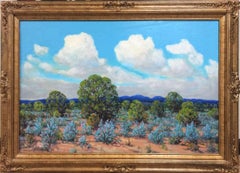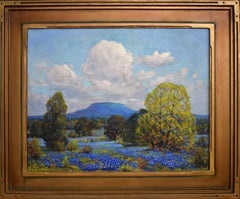Worth And Company
1980s Impressionist Landscape Paintings
Oil
Recent Sales
1970s Impressionist Landscape Paintings
Oil
1980s American Impressionist Landscape Paintings
Oil
People Also Browsed
Antique 18th Century Spanish Baroque Decorative Boxes
Iron
Vintage 1980s Spanish Benches
Iron
Antique Late 19th Century Danish Country Apothecary Cabinets
Brass
Vintage 1960s Urns
Terracotta
20th Century Peruvian Spanish Colonial Wall Mirrors
Glass, Mirror, Giltwood
Antique 17th Century Spanish Paintings
Canvas
20th Century Mexican Spanish Colonial Armchairs
Leather, Walnut
Early 20th Century Spanish Moorish Textiles
Silk
Vintage 1920s Spanish Paintings
Canvas
Antique Late 19th Century Spanish Sunburst Mirrors
Mirror, Wood
Antique Late 17th Century Spanish Renaissance Armchairs
Walnut
Vintage 1950s Peruvian Paintings
Wood
Antique 1650s Spanish Baroque Blanket Chests
Walnut
Vintage 1920s Peruvian Spanish Colonial Benches
Wood
Antique Late 19th Century Baroque Cupboards
Marble
Antique Late 18th Century Spanish Spanish Colonial Chairs
Leather, Ebony
Worth And Company For Sale on 1stDibs
How Much is a Worth And Company?
Dwight Holmes for sale on 1stDibs
Dwight C. Holmes, known for ornamental architectural sculpting as well as painting and etching, was born in Albany, Oregon, in 1900. He began formal art training at the Ball High School in Galveston; studied five years in the Texas Christian University, serving also as a student assistant and art editor for the College annual. He received his Certificate of Art and Bachelor of Arts degree and became a faculty member in the Art Department. He left teaching to serve a five-year apprenticeship to achieve membership in Modelers and Sculptors of America. He studied with George Franz of Germany and Michael Lengyl of Austria. He has done ornamental architectural sculpting over 40 years and enjoys a broad art horizon that includes sculpting, painting, designing, ceramics, carving, gold-leafing, restoration, etc. He paints in any medium and any subject matter but prefers oils and landscapes. He studied at the Texas Christian University with Mary Sue Darter Coleman, Mrs. R. E. Cockerell, Sam P. Ziegler, and others. In California, he studied with George Flowers, at the Art Institute in Pasadena, and in workshops with Lee McCarthy, Leonard Boreman, and etching with Bernard Wall. He held membership in the Painters' Club and Fort Worth Art Association; the American Federation of Art; the River Art Group and Coppini Academy of Fine Arts in San Antonio; the Southwest Ceramic Society; the San Angelo Art Club and Arts Council, and others. Dwight Holmes began winning art awards at age 13 and has continued receiving numerous honors and awards over the years. He held art exhibits all over the Southwest, from Florida to California. His works have been shown in Boston, Cleveland, New York, Kansas City, Columbia, Missouri and elsewhere. He has painted along the Gulf, East and West Coasts; throughout Texas; in Mexico, New Mexico, Arizona, Utah, Colorado, California, Tennessee, Georgia, in the Great Smokies, Yellowstone, Grand Tetons, Red Rock Country, Hawaii, etc. He maintained a studio at 2401 Sherwood Way, San Angelo, Texas, but enjoys doing much of his painting out on locations, His interests included juror for shows; giving criticisms and appraisals, and conducting art workshops and art colonies. In addition to museums works by Dwight C. Holmes may be seen in many private collections including Mr. Levi Cole, banker, Canyon, Texas; Dr. A. McChesney, M.D., Columbia, Missouri; S. Herbert Hare, former President Nat'l Association Landscapes Architects; Mr. Scott, Quaker Oats Co; Mr. Moore, Anheuser Busch Co, New Orleans, Cecil Kangaroo, Insurance, Ft. Worth, James Buchanan Architect, Ft. Worth, and others. Several books have been published which give short histories of outstanding artists of Texas, in which Dwight C. Holmes is included: A History of Texas Artists and Sculptors by Fisk; Art and Artists of Texas by O'Brien; Art on the Texas Plains by Elsie M. Wilbanks. The following, also from Bill Cheek, is from the back of a signed Holmes print and personal communications of Raul Ruiz, a San Angelo artist and student of Holmes.
A Close Look at Impressionist Art
Emerging in 19th-century France, Impressionist art embraced loose brushwork and plein-air painting to respond to the movement of daily life. Although the pioneers of the Impressionist movement — Claude Monet, Edgar Degas, Paul Cézanne, Berthe Morisot, Camille Pissarro, and Pierre-Auguste Renoir — are now household names, their work was a radical break with an art scene led and shaped by academic traditions for around two centuries. These academies had oversight of a curriculum that emphasized formal drawing, painting and sculpting techniques and historical themes.
The French Impressionists were influenced by a group of artists known as the Barbizon School, who painted what they witnessed in nature. The rejection of pieces by these artists and the later Impressionists from the salons culminated in a watershed 1874 exhibition in Paris that was staged outside of the juried systems. After a work of Monet’s was derided by a critic as an unfinished “impression,” the term was taken as a celebration of their shared interest in capturing fleeting moments as subject matter, whether the shifting weather on rural landscapes or the frenzy of an urban crowd. Rather than the exacting realism of the academic tradition, Impressionist paintings, sculptures, prints and drawings represented how an artist saw a world in motion.
Many Impressionist painters were inspired by the perspectives in imported Japanese prints alongside these shifts in European painting — Édouard Manet drew on ukiyo-e woodblock prints and depicted Japanese design in his Portrait of Émile Zola, for example. American artists such as Mary Cassatt and William Merritt Chase, who studied abroad, were impacted by the work of the French artists, and by the late 19th century American Impressionism had its own distinct aesthetics with painters responding to the rapid modernization of cities through quickly created works that were vivid with color and light.
Find a collection of authentic Impressionist art on 1stDibs.
Finding the Right Landscape-paintings for You
It could be argued that cave walls were the canvases for the world’s first landscape paintings, which depict and elevate natural scenery through art, but there is a richer history to consider.
The Netherlands was home to landscapes as a major theme in painting as early as the 1500s, and ink-on-silk paintings in China featured mountains and large bodies of water as far back as the third century. Greeks created vast wall paintings that depicted landscapes and grandiose garden scenes, while in the late 15th century and early 16th century, landscapes were increasingly the subject of watercolor works by the likes of Leonardo da Vinci and Fra Bartolomeo.
The popularity of religious paintings eventually declined altogether, and by the early 19th century, painters of classical landscapes took to painting out-of-doors (plein-air painting). Paintings of natural scenery were increasingly realistic but romanticized too. Into the 20th century, landscapes remained a major theme for many artists, and while the term “landscape painting” may call to mind images of lush, grassy fields and open seascapes, the genre is characterized by more variety, colors and diverse styles than you may think. Painters working in the photorealist style of landscape painting, for example, seek to create works so lifelike that you may confuse their paint for camera pixels. But if you’re shopping for art to outfit an important room, the work needs to be something with a bit of gravitas (and the right frame is important, too).
Adding a landscape painting to your home can introduce peace and serenity within the confines of your own space. (Some may think of it as an aspirational window of sorts rather than a canvas.) Abstract landscape paintings by the likes of Korean painter Seungyoon Choi or Georgia-based artist Katherine Sandoz, on the other hand, bring pops of color and movement into a room. These landscapes refuse to serve as a background. Elsewhere, Adam Straus’s technology-inspired paintings highlight how our extreme involvement with our devices has removed us from the glory of the world around us. Influenced by modern life and steeped in social commentary, Straus’s landscape paintings make us see our surroundings anew.
Whether you’re seeking works by the world’s most notable names or those authored by underground legends, find a vast collection of landscape paintings on 1stDibs.


